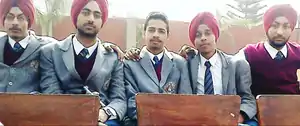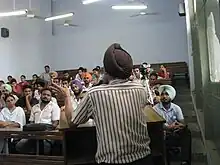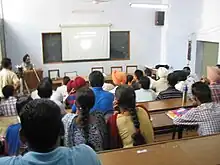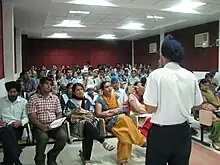Education in Punjab, India
Primary and secondary education

The Indian government lays emphasis on the primary education up to the age of fourteen years, referred to as elementary education in India. It has been a fundamental right enlisted in the constitution of the country under Article 21-A up till the age of 14 years. The Indian government has also banned child labour in order to ensure that the children do not enter unsafe working conditions.[1] However, both free education and the ban on child labour are difficult to enforce due to economic disparity and social conditions.[1] 80% of all recognized schools at the elementary stage are government run or supported, making it the largest provider of education in the country.[2]

However, due to a shortage of resources and lack of political will, this system suffers from massive gaps including high pupil to teacher ratios, shortage of infrastructure and poor levels of teacher training. Figures released by the Indian government in 2011 show that there were 5,816,673 elementary school teachers in India.[3] As of March 2012 there were 2,127,000 secondary school teachers in India.[4] Education has also been made free[1] for children for 6 to 14 years of age or up to class VIII under the Right of Children to Free and Compulsory Education Act 2009.[5]
There have been several efforts to enhance quality made by the government. The District Education Revitalization Programme (DERP) was launched in 1994 with an aim to universalize primary education in India by reforming and vitalizing the existing primary education system.[6] 85% of the DERP was funded by the central government and the remaining 15 percent was funded by the states.[6] The DERP, which had opened 160000 new schools including 84000 alternative education schools delivering alternative education to approximately 3.5 million children, was also supported by UNICEF and other international programmes.[6]
This primary education scheme has also shown a high Gross Enrollment Ratio of 93–95% for the last three years in some states.[6] Significant improvement in staffing and enrollment of girls has also been made as a part of this scheme.[6] The current scheme for universalization of Education for All is the Sarva Shiksha Abhiyan which is one of the largest education initiatives in the world. Enrollment has been enhanced, but the levels of quality remain low.
The table below shows the district level teacher to pupil ratio from class 1 to 5 in Punjab, as of 2017.[7][8][9][10]
| District | Ratio | |
|---|---|---|
| Hoshiarpur | 15 | |
| Rupnagar | 16 | |
| Fatehgarh Sahib | 16 | |
| SAS Nagar | 17 | |
| SBS Nagar | 18 | |
| Gurdaspur | 18 | |
| Pathankot | 19 | |
| Kapurthala | 20 | |
| Faridkot | 20 | |
| Sri Muktsar Sahib | 20 | |
| Jalandhar | 21 | |
| Sangrur | 21 | |
| Patiala | 22 | |
| Ludhiana | 24 | |
| Bathinda | 24 | |
| Barnala | 26 | |
| Fazilka | 27 | |
| Amritsar | 30 | |
| Ferozpur | 30 | |
| Mansa | 30 | |
| Moga | 31 | |
| Taran taran | 46 |
Secondary education

The National Policy on Education (NPE), 1986, has provided for environment awareness, science and technology education, and introduction of traditional elements such as Yoga into the Indian secondary school system.[11] Secondary education covers children aged 14 to 18, 88.5 million children according to the Census, 2001.
A significant feature of India's secondary school system is the emphasis on inclusion of the disadvantaged sections of the society. Professionals from established institutes are often called to support in vocational training. Another feature of India's secondary school system is its emphasis on profession based vocational training to help students attain skills for finding a vocation of his/her choosing.[12] A significant new feature has been the extension of SSA to secondary education in the form of the Rashtriya Madhyamik Shiksha Abhiyan.[13]
A special Integrated Education for Disabled Children (IEDC) programme was started in 1974 with a focus on primary education.[14] but which was converted into Inclusive Education at Secondary Stage[15] Another notable special programme, the Kendriya Vidyalaya project, was started for the employees of the central government of India, who are distributed throughout the country. The government started the Kendriya Vidyalaya project in 1965 to provide uniform education in institutions following the same syllabus at the same pace regardless of the location to which the employee's family has been transferred.[14]
Schools of Repute
- Army Public School, Patiala[16]
- Little Flower Convent School, Dhariwal
- Cambridge International school, Dasuya
- DAV Public School, Amritsar
- Doon International School, Amritsar
- Doon International school, Gurdaspur
- DPS Ludhiana
- Government High Smart School Mauran, Barnala
- Guru Teg Bahadur International School, Dhariwal
- Indus World School, Ludhiana
- Kundan Vidya Mandir Sen Sec. School, Ludhiana[17]
- Rayat International school, SBS Nagar
- Patel Memorial National College, Rajpura[18]
- Ryan International School, Amritsar
- Ryan International School, Ludhiana
- Shivalik Public School, Mohali
- Sainik School, Kapurthala
- Yadavindra Public School, Patiala
- Yadavindra Public School, Mohali
- The Punjab Public School, Nabha
- St.Xavier's High School, Rampuraphul
Tertiary education

Punjab is served by many public institutes of higher education (listed below). All the major arts, humanities, science, engineering, law, medicine, veterinary science, and business courses are offered, leading to first degrees as well as postgraduate awards. Advanced research is conducted in all major areas of excellence. Punjab Agricultural University is one of the world's leading authorities in agriculture. It was instrumental and played vital role in Punjab's Green Revolution in the 1960s-70s.
Central
- Central University of Punjab, Bathinda
State
- Panjab University, Chandigarh (a Punjab State University[19])
- Baba Farid University of Health Sciences, Faridkot
- Guru Nanak Dev University, Amritsar
- Maharaja Ranjit Singh Punjab Technical University,[20][21] Bathinda
- Punjabi University, Patiala
- Punjabi University Regional Centre for IT and Management,[22] Mohali
- Punjabi University Guru Kashi Campus, Talwandi Sabo
- Guru Ravidas Ayurved University, Hoshiarpur
- Guru Angad Dev Veterinary and Animal Sciences University, Ludhiana
- Sri Guru Teg Bahadur State University of Law, Taran Taran
- Rajiv Gandhi National University of Law, Patiala
- Jagat Guru Nanak Dev Punjab State Open University[23]
Private
- Adesh University, Bathinda
- Thapar University
- Apeejay Institute of Management[24]
- Sri Guru Granth Sahib World University, Fatehgarh Sahib
- GGS College of Modern Technology, Kharar
- Indian School of Business, Ajitgarh
- Guru Kashi University, Talwandi Sabo
- DAV University, Jalandhar
- GNA University, Phagwara
- Sant Baba Bhag Singh University, Jalandhar
- Akal University
Deemed

Autonomous colleges in Punjab

Many colleges of Punjab have been granted autonomous status by UGC.
- Khalsa College, Amritsar
- Mata Gujri College, Fatehgarh Sahib
- S.G.G.S. Khalsa College, Mahilpur (Hoshiarpur district)
- Amritsar College of Engineering & Technology
- Beant College of Engineering and Technology Gurdaspur
- Shaheed Bhagat Singh State Technical Campus, Ferozepur
- Guru Nanak Dev Engineering College, Ludhiana[25]
Reputed colleges (Technical /Professional)

- Apeejay Institute of Management & Engineering Technical Campus, Jalandhar (Punjab)[24]
- Sikh Missionary College, Ludhiana
- Desh Bhagat Group of Institutes, Gobindgarh, Moga, Muktsar under Desh Bhagat University
- Indian Institute of Technology, Ropar
- Indian Institute of Management Amritsar[26]
- Indian Institute of Science Education and Research, Mohali
- Dr B R Ambedkar National Institute of Technology, Jalandhar
- Global Institute of Management & Emerging Technologies, Amritsar
- Institute of Nano Science and Technology
- Giani Zail Singh Punjab Technical University Campus (Government Engineering College), Bathinda
- Yadavindra College of Engineering, Punjabi University Guru Kashi Campus, Talwandi Sabo
- Malout institute of Management & Technology, Malout ( Govt. of Punjab)
- Bhutta College of Engineering & Technology, Ludhiana
- Malwa College of Nursing
- Baba Banda Singh Bahadur Engineering college,Fatehgarh Sahib
- Sri Sukhmani Institute of Engineering & Technology, Dera Bassi(Mohali)
Other Institutes of Repute (General)
- Aryabhatta group of institutions, Barnala[27]
- BBK DAV College for Women, Amritsar
- BCM College of Education, Ludhiana
- College of Engineering and Management, Kapurthala
- Patel Memorial National College, Rajpura[18]
- Council of Computer Education Research and Training, Ludhiana
- Desh Bhagat Group of Institutes, Gobindgarh, Moga, Muktsar under Desh Bhagat University
- [Doraha college of Education, Doraha]
- GHG Khalsa College of Education, GURUSAR Sudhar
- Govt. Bikram College of Commerce, Patiala
- Govt. College of Education, Sector 20 Chandigarh
- Govt. Barjinder College, Faridkot
- Desh Bhagat Pt. Chetan Dev Govt.College of Education, Faridkot
- Malwa Group of Institutions
- Khalsa College, Patiala
- Kings Group of Institutions, Barnala,Punjab
- Malwa College of Nursing, Kotkapura
- Mohindra College, Patiala
- PCTE Group of Institutes (including Punjab College of Technical Education), Ludhiana
- Punjab Engineering College, Chandigarh
- Regional Centre Punjabi University, Bathinda
- SGGS Khalsa College Sector 26 Chandigarh
- State College of Education, Patiala
- Swami Sarvanand Giri Panjab University Regional Centre, Hoshiarpur
Government Medical Colleges
Private Medical Colleges
- Gian Sagar Medical College & Hospital, Patiala
- Sri Guru Ram Das Institute of Medical Sciences & Research, Sri Amritsar
- Punjab Institute of Medical Sciences, Jalandhar[29]
- Christian Medical College, Ludhiana
- Dayanand Medical College & Hospital, Ludhiana
- Adesh Institute of Medical Sciences & Research, Bathinda
- Chintpurni Medical College, Gurdaspur
- Desh Bhagat School of Medical Sciences, Mandi Gobindgarh Desh Bhagat University
Statistics
The table below shows the district level teacher to pupil ratio from class 1 to 5 in Punjab, as of 2017.[7][30][31][32]
| Sr. No. | District | Ratio |
|---|---|---|
| 1 | Hoshiarpur | 15 |
| 2 | Rupnagar | 16 |
| 3 | Fatehgarh Sahib | 16 |
| 4 | SAS Nagar | 17 |
| 5 | SBS Nagar | 18 |
| 6 | Gurdaspur | 18 |
| 7 | Pathankot | 19 |
| 8 | Kapurthala | 20 |
| 9 | Faridkot | 20 |
| 10 | Sri Muktsar Sahib | 20 |
| 11 | Jalandhar | 21 |
| 12 | Sangrur | 21 |
| 13 | Patiala | 22 |
| 14 | Ludhiana | 24 |
| 15 | Bathinda | 24 |
| 16 | Barnala | 26 |
| 17 | Fazilka | 27 |
| 18 | Amritsar | 30 |
| 19 | Ferozpur | 30 |
| 20 | Mansa | 30 |
| 21 | Moga | 31 |
| 22 | Taran taran | 46 |
The table below shows the average population per school in each district of Punjab, as of 2011 census and the total number of schools, as of 2017. This includes government schools, affiliated schools, recognised and aided schools.[33] Note:- Pathankot and Fazilka were part of Gurdaspur and Ferozepur respectively, before 2011, so separate data for them regarding the average population per school is not available.
| Sr. No. | District | Average population per school (2011) | Total number of schools (2017) |
|---|---|---|---|
| 1 | SBS Nagar | 2,251 | 272 |
| 2 | Kapurthala | 2,433 | 335 |
| 3 | Fatehgarh Sahib | 2,480 | 242 |
| 4 | Gurdaspur | 2,582 | 637 |
| Pathankot | ---- | 193 | |
| 5 | Hoshiarpur | 2,584 | 614 |
| 6 | Moga | 2,613 | 381 |
| 7 | Faridkot | 2,616 | 236 |
| 8 | Rupnagar | 2,706 | 253 |
| 9 | Sangrur | 2,908 | 569 |
| 10 | Sri Muktsar Sahib | 2,918 | 309 |
| 11 | Mansa | 2,937 | 262 |
| 12 | Ferozpur | 3,023 | 419 |
| Fazilka | ---- | 252 | |
| 13 | Patiala | 3,251 | 583 |
| 14 | Barnala | 3,403 | 175 |
| 15 | Jalandhar | 3,476 | 631 |
| 16 | Bathinda | 3,533 | 393 |
| 17 | Amritsar | 3,722 | 669 |
| 18 | Ludhiana | 3,770 | 928 |
| 19 | SAS Nagar | 3,812 | 261 |
| 20 | Taran taran | 4,373 | 372 |
Notable people
- The former Prime Minister of India, Dr Manmohan Singh was educated at Panjab University, Chandigarh and Oxford and Cambridge in UK.
- Professor Har Gobind Khorana, famous Nobel laureate & biotechnologist was educated at Panjab University.
- Sushma Swaraj Leader of BJP is an alumnus of Panjab University Chandigarh
- IAS officer of 1989-batch, Iqbal Singh Chahal is the current BMC commissioner is an alumnus of Thapar Institute of Engineering and Technology Patiala
- Subodh Kumar Jaiswal, the current CBI director[34] from May 2021, is an MBA postgraduate from University Business School, Panjab University Chandigarh
References
- Blackwell, 93–94
- "DISE--District Information System for Education". www.dise.in. Archived from the original on 31 December 2008. Retrieved 17 January 2022.
- "dise.in" (PDF). www.dise.in.
- "Archived copy" (PDF). Archived from the original (PDF) on 17 April 2012. Retrieved 8 February 2016.
{{cite web}}: CS1 maint: archived copy as title (link) - "THE RIGHT OF CHILDREN TO FREE AND COMPULSORY EDUCATION ACT, 2009" (PDF). education.nic.in. Archived from the original (PDF) on 12 February 2012.
- India 2009: A Reference Annual (53rd edition), 215
- "District-wise Stage wise Teacher-Pupil Ratio of Class 1 to 5 from 1989 to 2017 (As of 30 September) | Open Government Data (OGD) Platform India".
- "District-wise Stage wise Teacher-Pupil Ratio of Class 6 to 8 from 1989 to 2017 (As of 30 September) | Open Government Data (OGD) Platform India".
- "District-wise Stage wise Teacher-Pupil Ratio of Class 9 to 10 from 1989 to 2017 (As of 30 September) | Open Government Data (OGD) Platform India".
- "District-wise Stage wise Teacher-Pupil Ratio of Class 11 to 12 from 1992 to 2017 (As of 30 September) | Open Government Data (OGD) Platform India".
- India 2009: A Reference Annual (53rd edition), 231
- Blackwell, 94–95
- Microsoft Word – Framework_Final_RMSA.doc Archived 2009-10-07 at the Wayback Machine. (PDF). Retrieved 21 March 2011.
- India 2009: A Reference Annual (53rd edition), 233
- Secondary Education Archived 2009-07-22 at the Wayback Machine. Education.nic.in. Retrieved 21 March 2011.
- "Army Public School Punjab". iCBSE. Retrieved 28 July 2016.
- "Kundan Vidya Mandir Ludhiana| Best School In Ludhiana". kundanvidyamandir.com.
- "Patel Memorial National College, Rajpura". patelcollege.in.
- "PU not central university: HC | Chandigarh News - Times of India". The Times of India. 5 March 2011.
- "The Tribune, Chandigarh, India - Punjab". www.tribuneindia.com.
- "Maharaja Ranjit Singh State Technical University on the campus of Giani Zail Singh College of Engineering and Technology in Bathinda". Archived from the original on 17 June 2016. Retrieved 23 December 2014.
- "PURCITM | PURCITM". Retrieved 14 May 2020.
- "Punjab govt to establish Open University in Guru Nanak's name".
- "Best College for MBA & B.Tech Courses in Jalandhar (Punjab)". aimetc.apeejay.edu.
- "Autonomous Colleges - University Grants Commission" (PDF). Archived from the original (PDF) on 18 October 2016. Retrieved 29 December 2014.
- "Budget 2014-15: IIM to be set up in Amritsar". India Today.
- "::: Best Engineering College in Punjab, India ::: Aryabhatta College of Engineering & Technology, Barnala :: Aryabhatta College of Management & Technology, Barnala ::: Courses :: B.Tech (CSE,ECE,ME,EE) MBA ::". www.aryabhattagroup.com.
- "Admissions for PMET 2015 on hold, High court issues notices". hindustantimes.com. 10 September 2015. Archived from the original on 13 September 2015. Retrieved 10 September 2015.
- "Official MCI website". Archived from the original on 7 June 2013.
- "District-wise Stage wise Teacher-Pupil Ratio of Class 6 to 8 from 1989 to 2017 (As of 30 September) | Open Government Data (OGD) Platform India".
- "District-wise Stage wise Teacher-Pupil Ratio of Class 9 to 10 from 1989 to 2017 (As of 30 September) | Open Government Data (OGD) Platform India".
- "District-wise Stage wise Teacher-Pupil Ratio of Class 11 to 12 from 1992 to 2017 (As of 30 September) | Open Government Data (OGD) Platform India".
- https://papers.ssrn.com/sol3/Delivery.cfm/SSRN_ID3690812_code4196221.pdf?abstractid=3674584&mirid=1
- "Subodh Kumar Jaiswal Biography: All you need to know about the new CBI Director". The Financial Express. 26 May 2021. Retrieved 12 June 2021.


